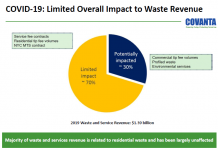For a number of years, this (now old and outdated, but) very useful chart has been in circulation in energy circles, mapping the supply of energy to the world by looking not at prices, but at production costs.
For one thing, it goes a long way to explaining why the price of oil can tumble so quickly when there is a fall off in demand, and explains why OPEC is troubled by unconventional oil in a way it is not so bothered by other energy sources such as renewable fuels.
Renewables not only have been traditionally at the expensive end of the curve, the supply has been generally quite limited when we look at total global demand. OPEC makes so much money off $100 oil that they don’t mind sacrificing a few market share points to other fuels, when demand spikes and prices reach those levels.
The shale oil revolution and its impact
Conversely, shale oils uncovered through US fracking operations to use another example are able to supply lots of oil to meet world demand at prices well below the OPEC target, and they can also be competitive with some of the more expensive conventional oils. So, they bite into market share and also price.
Updating the charts: Where does ethanol fit now in the cost curve?
Back then, ethanol fitted in the $90-$120 per barrel slot. But today, the cost of production has changed, dramatically. You can see it in this wonderful data set that Bruce Babcock and the Center for Agricultural and Rural Development at Iowa State have maintained for many years.
As you can see from the hard data, the production cost for ethanol today is $1.22 per gallon, which translates to $51.24 per barrel. Now, on an energy basis given that ethanol has 67% of the energy content of a barrel of oil, that translates to $76.86 on a barrel-of-oil-equivalent basis.
To make a fair comparison, we have to take into account the refining cost of making gasoline we need to compare finished ethanol and finished gasoline, not compare corn to gasoline or ethanol to crude oil. Estimates of the variable cost of refining are not easy to obtain and vary based on the product mix, cost of utility power and so on, but tacking on at least $4 per barrel is fair (this older estimate from PSU puts it at $20). The EIA has this data from 2012, here.
$76 is well above today’s oil price, even if you tack on $4 for refining costs to make gasoline. But it’s not well above the price that oil is expected to reach by next year, according to the wizards at Raymond James (whose energy desk correctly forecast the collapse in oil prices, so we approach their forecasts with great respect, although timing is always an issue with any projection). They expect oil to reach around $70 per barrel by the end of 2017. Of course, we’ll wait to see what impact that might have on corn prices, the price for DDGs and for corn oil but it would be a remarkable step in ethanol’s journey.
We’ve put the latest data from the IMF, and the new numbers for renewables, into the chart you see below.
As Aemetis CEO Eric McAfee notes:
“The general perception is that biofuels are more expensive to produce than petroleum fuel products. That perception is not accurate for the net cost of production of ethanol in the US after considering the value of animal feed byproducts (DGrain and corn oil) and CO2 production for the human food market.”
The impact of carbon on profitability
Let’s look at the impact of carbon.
Under the Renewable Fuel Standard, there’s an implied carbon credit for ethanol, and that’s in the value of the D6 RIN.
And that tells you that there’s a significant inflection point in ethanol and gasoline prices, and it’s this. If, one day, the production cost + the RIN cost of corn ethanol falls below any given source of conventional oils, it just makes economic sense for an obligated party to switch towards increased renewables production (as opposed to, say, investing in tight oil operations) not because of obligations to government, but because of obligations to shareholders. That’s a step-change.
And it’s getting close. Thanks to the pricing data from our friends at PFL, we see that the D6 RIN is trading at 41 cents per gallon.
That adds $17.22 in carbon value to a barrel of ethanol. Putting the ethanol production price together with the RIN price, it makes sense to buy or make as much ethanol as you can stuff into the system mandated or not starting at $55 per barrel.
That’s not far at all from the world oil price.
Over to the biodiesel side
All the same math applies in the world of biodiesel, but there are different data points. So let’s look at those.
Starting again with CARD’s data on operating costs, the production cost of biodiesel right now is at $2.76 per gallon, or $115 per barrel.
It happens that CARD data is based on the soybean oil price of $0.31 cents per pound. Technologies that can use recycled oils that are sold as low as $0.22 per pound will have a production cost of roughly $2.61 per gallon. Now, biodiesel is much closer to petroleum on energy density it’s between gasoline and diesel. So, depending on whether you want to compare biodiesel back to gasoline that comes out of a barrel of oil or to diesel, you’ll come up with a production cost range (on a barrel of oil equivalent basis) of $105-$115, after we’ve adjusted for energy density.
So, biodiesel is well above the $52 Brent crude oil price, right now. But biodiesel RINs are more valuable, and close the gap a little. According to PFL, D4 biomass-based diesel RINs are trading at $1.03 per gallon, and are adding $43.26 to the value of the barrel.
Putting the production price together with the RIN price, it makes sense to buy or make as much biodiesel as
you can stuff into the system mandated or not starting at $62-$72 per barrel. That’s high compared to today’s price, but inside the predicted crude oil price of $70 that we referenced above.
So, we live in interesting times and we’ve charted the costs and supply figures, taking carbon into account, in the chart below.
Considering California
When we look at the California market and its Low Carbon Fuel Standard (and Oregon, too, which also has an LCFS) we are looking at a different animal, since the carbon value is added on top of RIN credit values.
Right now, our friend at PFL advise that the LCFS credit price is at $74 per ton of carbon avoided. For locally-produced ethanol, that means around an additional $6.21 per barrel for ethanol delivered into the California market.
For biodiesel, the credit bites harder because biodiesel really, really reduces carbon. The LCFS credit translates into around $26.64 in added value for biodiesel.
Putting the ethanol production price together with the RIN price, it makes sense to buy or make as much ethanol as you can stuff into the California system mandated or not starting at $49 per barrel.
Putting the production price together with the RIN price, it makes sense to buy or make as much biodiesel as you can stuff into the system mandated or not starting at $36-$46 per barrel.
We’ve charted all that in this California-only chart below.
Two Takeaways
The current barrel of oil costs $49.38 (WTI) and $52.52 (Brent) right now. Which tells you two things:
1. The renewable fuel credit markets work with remarkable efficiency, after just a few years in operation. The credits reach almost exactly where they should, because a credit should in some ways make a mandate obsolete, it should incentivize a market player exactly to the point where they have a financial gain from deploying a renewable fuel. In the real world, incumbents don’t act with perfect economic rational actors, but you get the idea.
2. In California at least, a remarkable threshold has in fact been reached. In the actual markets that exist – carbon and fuel markets ethanol and biodiesel have achieved market parity. Now, you can argue all night that carbon markets are not free markets they are created by government fiat. And, you can argue all night that fuel markets are not free markets they are created by cartel fiat. And you’ll find supporters and detractors by the zillions, and the shouting will drive you crazy.
But they are markets, and they are the markets we have. And don’t get me started on how free and transparent financial markets really are, Mr. Madoff. But they are the markets we have, and in the markets we really have, we can say that markets in California are telling us this:
You can make more money producing ethanol than producing gasoline from petroleum, according to our math. And investors might take note because making money is generally what investors are trying to accomplish in the petroleum markets.
So, a step change worth noting.
[A brief explanatory note. As a sharp-eyed Digest reader noted, the CARD model tracks what may be considered “operating costs” and excludes amortization, depreciation and so forth if all those were added in, the “production cost” would be higher as high as $1.46 per gallon, vs $1.22 per gallon. So, why exclude those? As it happens, the EIA model for oil refinery costs (that we noted above) also excludes amortization, depreciation and so forth, which is why the refining add-on is $4 per barrel instead of $20-$30. Since we don’t have a good source of overall oil refinery costs, these capex related costs were excluded for both, to esnure that we are comparing apples to apples. If you like, you can add $10-$15 per barrel to both sides of the equation to account for these charges, and it doesn’t change the comparison, but you may feel that although it would be an approximation, it may be closer to a fully-loaded “production cost” as opposed to an “operating cost”.]
Jim Lane is editor and publisher of Biofuels Digest where this article was originally published. Biofuels Digest is the most widely read Biofuels daily read by 14,000+ organizations. Subscribe here.












